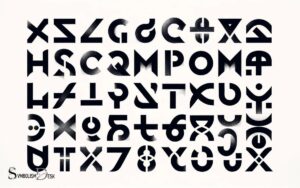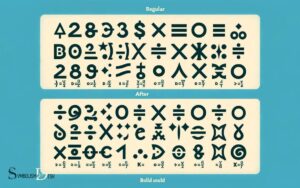Latex Math Line Over Symbol: Explain!
To create a line over a symbol in LaTeX, you can use the \overline command. Place the symbol or expression you want to cover with a line inside the curly braces following the command. If you want to put a line over the letter k, you would write \overline{k} in your LaTeX document.
The \overline command is used in LaTeX to indicate that a certain symbol or group of symbols should be considered as a single entity with a line above them.
This can have different meanings depending on the context, such as denoting a geometric line segment given by two points, the conjugate in complex numbers, or the mean value in statistics.
Here are some examples of using the \overline command:
\overline{AB}to represent a line segment between points A and B.\overline{z}to denote the complex conjugate of a complex number z.\overline{x}to indicate the mean (average) of a set of values x.
The \overline command in LaTeX is versatile and essential for producing professional mathematical documents, maintaining clarity and precision in the notation.

Key Takeaway
Understanding LaTeX Math Notation
Understanding LaTeX math notation involves mastering the syntax and structure of mathematical expressions within the LaTeX typesetting system.
LaTeX provides a powerful and flexible way to typeset mathematical equations, making it a popular choice among researchers, academics, and professionals.
It allows for the creation of complex mathematical formulas, symbols, and notation, enabling precise and clear representation of mathematical concepts.
A key aspect of understanding LaTeX math notation is the use of commands and environments to express various mathematical elements such as fractions, exponents, integrals, and matrices.
Additionally, it is essential to grasp the concept of mathematical modes, including inline and display modes, which impact the layout and formatting of mathematical expressions within a document.
Implementing Math Symbols in LaTeX
In the implementation of math symbols in LaTeX, it is essential to understand the use of line over variables, the various math symbol commands available, and the font styles specific to mathematical notation.
These points form the foundation for effectively incorporating mathematical symbols and expressions into LaTeX documents.
By exploring these aspects, we can gain a comprehensive understanding of how to accurately represent mathematical concepts within the LaTeX environment.
Line Over Variables
The line over variables in LaTeX, also known as a bar or overline, is utilized to indicate a mathematical operation or function involving a variable. This notation is commonly used to represent the mean of a set of values.
In LaTeX, the overline command is implemented as . For instance, to represent the mean of a variable x, the notation would be .
This notation can also be used to denote complex conjugates in mathematics. When typesetting mathematical expressions, it is essential to use the appropriate notation to ensure clarity and precision in conveying mathematical operations.
Therefore, understanding the implementation of line over variables is crucial for accurately representing mathematical functions and operations in LaTeX.
Math Symbol Commands
Implementing math symbols in LaTeX requires careful use of quantifier determiners to accurately represent mathematical expressions. LaTeX provides a wide range of math symbol commands that enable the inclusion of complex mathematical notations.
These commands allow for the inclusion of symbols such as Greek letters, set notations, operators, and relations. For instance, the command represents the Greek letter alpha, while represents the union symbol.
Additionally, LaTeX offers the flexibility to create custom math symbols using the ewcommand feature, allowing for the creation of personalized symbols when necessary.
Understanding and utilizing these math symbol commands is essential for effectively communicating mathematical concepts in LaTeX documents.
Font Styles for Math
Understanding and utilizing the various font styles for math in LaTeX is crucial for effectively representing mathematical expressions, and it builds upon the foundation of math symbol commands discussed previously.
When implementing math symbols in LaTeX, consider the following font styles:
- for bold symbols
- for italic symbols
- for upright symbols
for calligraphic symbols. Each font style serves a specific purpose in mathematical typesetting, allowing for clear and precise representation of mathematical concepts.
By mastering these font styles, one can enhance the visual presentation of mathematical expressions in LaTeX. Transitioning from font styles, the subsequent section will delve into the utilization of overlines in mathematical equations.
Utilizing Overlines in Mathematical Equations
The use of overlines in mathematical equations serves several important purposes. Firstly, overlines are commonly used to denote vectors in mathematics, representing the magnitude and direction of a quantity.
Additionally, overlines can be employed to indicate the notation for averages in statistical analysis, providing a clear and concise representation of the mean value of a set of data.
Furthermore, in the context of complex numbers, overlines are utilized to denote the conjugate of a complex number, playing a crucial role in various mathematical operations and applications.
Overline for Vectors
When typesetting mathematical equations in LaTeX, an overline can be used to denote a vector by placing it over the symbol representing the vector. This is commonly used in various fields such as physics, engineering, and mathematics to distinguish vectors from scalar quantities.
Utilizing overlines in mathematical equations for vectors offers the following benefits:
- Provides a clear visual indication that a quantity is a vector.
- Helps to distinguish vectors from scalars, aiding in the understanding of mathematical expressions.
- Conveys important information about the nature of the quantity being represented in the equation.
- Enhances the readability and clarity of mathematical notation, particularly in complex equations involving multiple variables and quantities.
Notation for Averages
In mathematical notation, the utilization of overlines for averages provides a concise and visually distinctive representation, building upon the clarity and distinction offered by overlines for vectors.
When representing the average of a set of values, an overline is placed above the variable or expression, such as $\overline{x}$ for the average of the variable x.
This notation simplifies the representation of averages in mathematical equations and sets them apart from other variables or constants.
For instance, in statistical analysis, the use of overlines for averages allows for clear and succinct notation, aiding in the comprehension of mathematical expressions and formulas.
Conjugate in Complex Numbers
Utilizing overlines in mathematical equations, the conjugate in complex numbers plays a crucial role in operations and analysis involving complex quantities.
- The conjugate of a complex number is obtained by changing the sign of the imaginary part.
- It is denoted by adding an overline, such as in the expression z̅ for the conjugate of z.
- The product of a complex number and its conjugate yields the square of its magnitude.
- Taking the conjugate is essential for various operations, including division and finding the modulus of complex numbers.
Understanding the concept of conjugates and their application in complex number operations is fundamental in various fields, including electrical engineering, physics, and advanced mathematics.
Applying Overlines to Specific Symbols
To achieve consistent formatting and clarity in mathematical expressions, applying overlines to specific symbols is crucial for highlighting their significance within the context of the equation.
Overlines, often used to denote complex conjugates or bar notation in statistics, can be applied to various symbols such as variables, constants, or entire expressions.
For instance, in the context of complex numbers, representing a complex conjugate of a given symbol is essential for various operations and properties.
By applying overlines to specific symbols, the mathematical meaning and operations can be clearly conveyed, aiding in the comprehension of the underlying concepts.
This consistent notation helps in distinguishing between different types of quantities and operations, ensuring precision in mathematical communication.
Understanding the significance of applying overlines to specific symbols is fundamental for effectively conveying mathematical ideas.
LaTeX Command for Line Over Symbol
Discussing the implementation of the LaTeX command for a line over a symbol is essential for understanding its application in typesetting mathematical expressions. The LaTeX command for a line over a symbol is \overline{symbol}. This command is useful for denoting the average of a variable in mathematical equations. It is also commonly used to indicate a conjugate in complex analysis and to represent a line in geometry. Additionally, understanding the implementation of the LaTeX command for a line over a symbol is crucial for typesetting degree symbol in mathematical and scientific documents.
The command in LaTeX is used to draw a line over a single symbol or a group of symbols. This command is beneficial for indicating conjugates, means, or set closures in mathematical notation.
Understanding how to use the command can enhance the clarity and professionalism of mathematical expressions in documents and publications. It is crucial to grasp the syntax and proper usage of this command to accurately represent mathematical concepts.
Utilizing the command can significantly improve the visual presentation of mathematical expressions, making them more accessible and comprehensible for readers.
Enhancing Math Clarity With Overlines
How can the use of overlines enhance the clarity of mathematical expressions in LaTeX? Overlines are a valuable tool for emphasizing and clarifying mathematical symbols and expressions in LaTeX.
By placing an overline above a symbol or expression, it effectively highlights and distinguishes it from the surrounding content, aiding in the reader’s comprehension.
This is particularly beneficial when dealing with complex equations or when specific variables or terms need to be emphasized.
Overlines serve to draw attention to critical components of the mathematical notation, thereby enhancing the overall clarity of the content for the reader.
In the subsequent section, we will delve into various overlining techniques in LaTeX to further explore their application and effectiveness in mathematical expressions.
Overlining Techniques in LaTeX
The overlining techniques in LaTeX provide a powerful means of emphasizing and clarifying mathematical symbols and expressions.
When using LaTeX for overlining, there are several techniques to consider:
- Utilizing the command to create a single line over a symbol.
- Employing the command to underline a symbol or expression.
- Combining overline and underline commands to create double-overlined or double-underlined symbols.
- Adjusting the line thickness and spacing using packages such as soul or ulem for more customized overlining effects.
Understanding these techniques allows for the effective presentation of mathematical notation, enhancing the clarity and emphasis of key symbols and expressions within LaTeX documents.
Conclusion
LaTeX math notation offers a powerful tool for typesetting mathematical equations with clarity and precision. By implementing overlines, specific symbols can be highlighted and emphasized, enhancing the visual representation of mathematical expressions.
How can the use of overlines in LaTeX math notation elevate the understanding and impact of complex mathematical concepts for readers and students alike?






